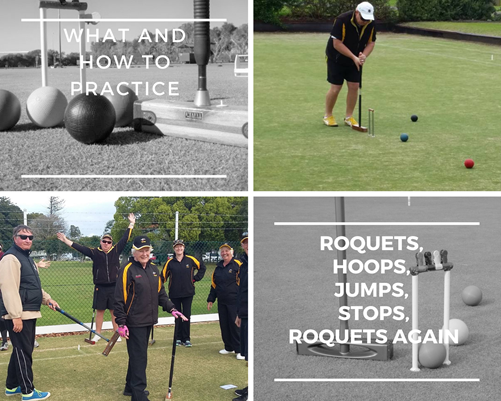What and how to practice

In a practice sense at the moment I would suggest trying a 30-60 minute session 1-2 times per week over and above any games played. When playing the games don’t focus so much on winning the game but controlling hoops. Try to manipulate situations where you are likely to get 2 hoops in a row. Don’t just make a hoop for the sake of making a hoop… look at all the balls and work out ways you think you can have the best chance of scoring the next one whether this be through jawsing, promotions, ricochets, blocks or clearances.
For me I would spend 5-10 minutes warming up your swing and roquets. I tend to just follow one ball randomly around the court and just pick a hoop leg on any hoop, shoot for it and then choose another hoop leg etc. I find it is better to just do the circuit of the 3 closest hoops (1,4 & 5) and just keep going in a circle until I am happy that I am swinging freely and hitting fairly straight. This could take 2 minutes or it could take 20… It all depends on how “easy” it feels.
The next 5-10 would be hoop running. Stay within the attacking zones 35 degrees either side of the hoop centre line. I would shoot 3-4 balls at about 4 different distances working back from 1m to the boundary. Perhaps do double from the boundary so you are comfortable with this shot. Work out what works best for you to score from the boundary (pace/mallet tilt etcetera).
The next 5-10 is within the 35-45 degree jawsing zone also working back to the boundary.
The next 5-10 is trying to jaws up to about 1m from the hoop max but all angles from 15 degrees out to about 85. Although I have identified the jawsing zone only up to 45 degrees depending on the lawn you can achieve it up to 85 degrees when you are close in on the hoop. Work out where the best spots for you to successfully jaws a ball are. The next 5-10 is jump shots. It is likely you will need to do at least 1 jump a game so it is best to be comfortable with the shot. You really need to find your range – i.e. how close can you get and keep the shot legal and consistently hit it 75% of the time. Work your way back and see how far away you can actually achieve a jump consistently. Learn how to do the “tilted drive” jump shot. That is you hit the ball with the pace to rush a ball across the lawn and you hit it with a tilted mallet and the ball at your toes. This produces a long flat jump as opposed to the usual up and down jump that people are taught with the ball at your ankles. Can you do a double jump? Try some longer ones where you bounce the ball through the hoop. You need this information to judge your game decisions.
30 strokes is useful by yourself but I prefer to just play a game against myself.
If you have time go back to roquets. Now you are warmed up you should be more accurate at hitting hoop legs and balls etc… Whatever you do for roquet training. I would suggest that you try “controlled clearances”. This is a shot that will play more and more as players think about the game. Basically practice roquet distances between 1/4 and 1/2 court distance that push an opponents ball off line so it can’t score. If your ball stays close to the hoop your opponent can no longer simply go back in front as you can clear them the second time too easily.
Practice summary – roquets, hoops, jumps, stops if you have time, roquets again. These are the bread and butter of golf croquet.
Game summary – first to the hoop get in front, jaws odd hoops, know the score, play to the skinny side wherever possible and look for promotions and ricochets.
This was the final part of the series – Golf Tactics and Options. I would like to thank Chris again for his willingness to share with us mere mortals his thoughts and ideas that have been built up over many years from playing croquet at the highest levels. It has been greatly appreciated.
You can go back and review all of his thoughts from the links below. I have re-read them many times, especially before a tournament and I never tire of it.

